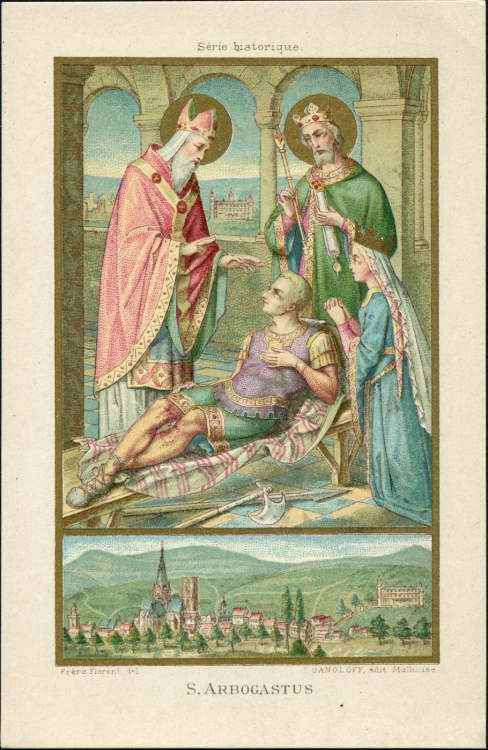St. Arbogast
(Gaelic Arascach).
St. Arbogast has been claimed as a native of Scotland, but this is owing to a misunderstanding of the name “Scotia”, which until late in the Middle Ages really meant Ireland. He flourished about the middle of the seventh century. Leaving Ireland, as so many other missionaries had done, he settled as a hermit in a German forest, and then proceeded to Alsace, where his real name, Arascach, was changed to Arbogast. This change of name was owing to the difficulty experienced by foreigners in pronouncing Irish Christian names; thus it is that Moengal, Maelmaedhog, Cellach, Gillaisu, Gilla in Coimded, Tuathal, and Arascach were respectively transformed into Marcellus, Malachy, Gall, Gelasius, Germanus, Tutilo, and Arbogast. St. Arbogast found a warm friend in King Dagobert II of Austrasia, who had been educated at Slane, in Meath, in Ireland, and was restored to his kingdom on the demise of King Childeric II. Monstrelet authenticates the story of King Dagobert in Ireland; and the royal exile naturally fled to Slane in order to be under the ægis of the Ard-Righ (High-King) of Ireland, at Tara. On Dagobert’s accession to the throne of Austrasia, Arbogast was appointed Bishop of Strasburg, and was famed for sanctity and miracles. It is related that the Irish saint raised to life Dagobert’s son, who had been killed by a fall from his horse. St. Arbogast died in 678, and, at his own special request, was buried on the side of a mountain, where only malefactors were interred. The site of his burial was subsequently deemed suitable for a church. He is commemorated 21 July.
Grattan Flood, Irish Saints; Boschius in Acta SS. (1727), July, V, 168-177; Burgener, Helvetia Sancta (1860), I, 56-58; Hist. litt. de la France (1735), III, 621-622; Postina, in Römische Quartalschrift (1898), XII, 299-305; Analecta Bolland., XVIII, 195; Bibl. hagiogr. Lat. (1898), 106, 1317; O’Hanlon, Lives of Irish Saints, VII (21 July); Wattenbach, Deutschlands Geschichtsquellen, 6th ed.; Grandidier, Hist de l’église de Strasbourg (1770), I, 199.
W. H. Grattan-Flood (Catholic Encyclopedia)










